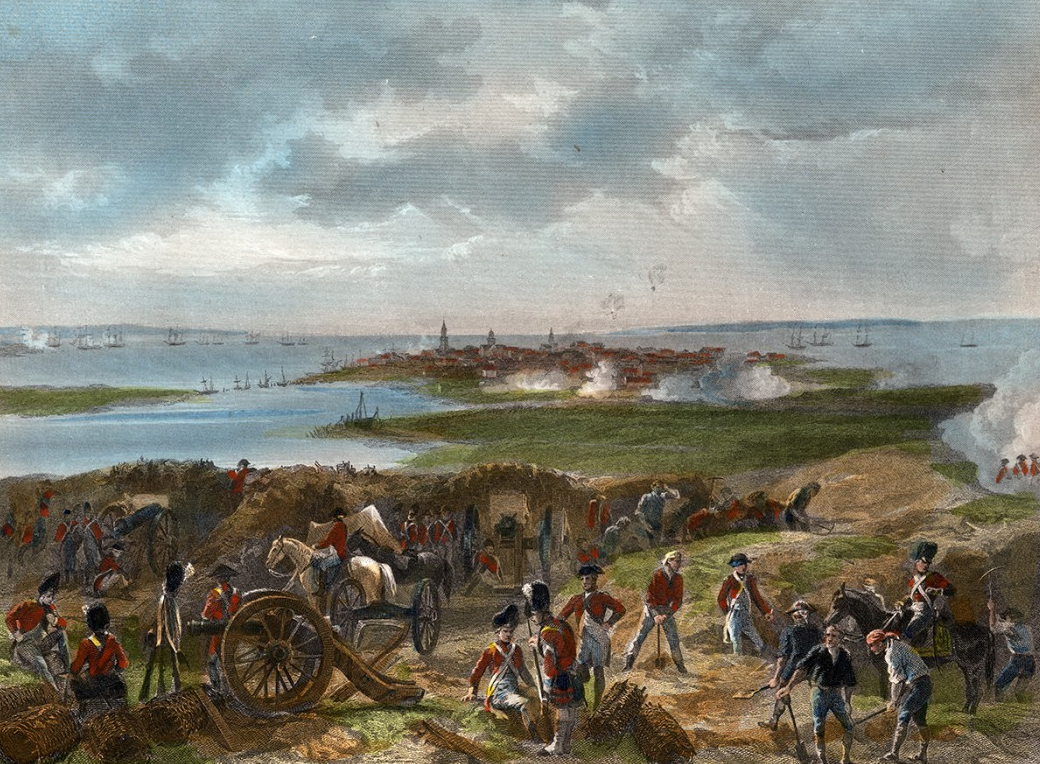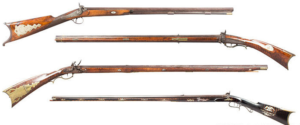After a siege that began on April 2, 1780, Americans suffer their worst defeat of the revolution on this day in 1780, with the unconditional surrender of Major General Benjamin Lincoln to British Lieutenant General Sir Henry Clinton and his army of 10,000 at Charleston, South Carolina.
With the victory, the British captured more than 3,000 Patriots and a great quantity of munitions and equipment, losing only 250 killed and wounded in the process. Confident of British control in the South, Lieutenant General Clinton sailed north to New York after the victory, having learned of an impending French expedition to the British-occupied northern state. He left General Charles Cornwallis in command of 8,300 British forces in the South.
South Carolina was a deeply divided state, and the British presence let loose the full violence of a civil war upon the population. First, the British used Loyalists to pacify the Patriot population; the Patriots returned the violence in kind. The guerrilla warfare strategies employed by Patriots Francis Marion, Thomas Sumter and Nathanael Greene throughout the Carolina campaign of 1780-81 eventually chased the far more numerous British force into Virginia, where they eventually surrendered at Yorktown on October 19, 1781.
Having suffered the humiliation of surrendering to the British at Charleston, Major General Lincoln was able to turn the tables and accept Cornwallis’ ceremonial surrender to General George Washington at Yorktown on October 20.
Of the many weapons lost, none were more important to an eventual American victory than the Kentucky Long. Long rifles were an American design of the 18th century, produced by individual German gunsmiths in Pennsylvania. Based on the Jäger rifle,[3] long rifles known as “Pennsylvania Rifles” or later known as “Kentucky Rifles” were used by snipers and light infantry throughout the Revolutionary War.
The great Kentucky flintlock-hunting rifle was more accurate than any known previous firearm and soon became famous. The history of Tennessee, Kentucky, and certainly the history of the United States, are each very much connected with the history of the Kentucky Long Rifle. This rifle is also known as the Kentucky, the hog rifle, or the long rifle. It was designed to be light, slender and graceful, and was the first truly American firearm. Created in the 1730s in Lancaster, Pennsylvania, by skillful immigrant craftsmen from Germany and Switzerland, the Kentucky rifle was the supreme implement created as a state of the art, ultimately for over a century, until the coming of the “cap and ball” percussion rifle in 1840.
The guns of the first American colonists were not rifles at all. They were smoothbore flintlock muskets imported from Europe. For a number of reasons, these old muskets were not suitable for the American frontier. First of all, they were so heavy that to go hunting with one became a significant chore.
The Brown Bessies, as they were called, fired spherical balls of lead and required large balls in order to get weight and striking force. Their diameter was gauged from 0.60 to 0.70 inches in caliber, with corresponding robust recoil when fired. They were therefore wasteful of powder and lead, both being in short supply on the American frontier.
The large balls of the Bessies created other problems. They had high air-resistance, which slowed them greatly, giving them shorter range. Since the balls had no spin to balance the turbulence caused by slight surface imperfections, they curved viciously in flight, much like a pitched spitball does in the game of baseball. This unpredictable motion rendered these muskets ineffective beyond a range of about 60 yards.
These assorted imperfections were prevailed over by the Lancaster gunsmiths. First they reduced the bores of the Kentucky to 0.45 to 0.50 caliber, so that one pound of lead, poured into iron molds, would produce from 70 to 120 round balls to be used for bullets, therefore conserving valuable lead.
Next the barrel length was increased to 40 inches, in essence, so as to get extra thrust from the expanding gunpowder. The Kentucky Rifle had a greatly improved range compared to the Brown Bessie, which was fitted with a 30-inch barrel.
In its finality, the Kentucky was “rifled,” with helical grooving in the barrel. This conveys rotary motion to the fired bullet on an alignment that coincided with the line of its flight trajectory. This spin gives rifles greater range and accuracy, compared to smoothbores.
The Kentucky Long Rifle was more accurate than any known previous firearm, and it soon became famous with a flight being deadly at over 200 yards, which was an astonishing range at that time.
This rifle became the primary weapon of the frontiersmen, especially in the isolated and hazardous wilds of Tennessee and Kentucky. The extensive use in Kentucky led to the adoption of the name ” Kentucky” for this rifle. Daniel Boone carried a Kentucky Rifle through Cumberland Gap.
During the Revolutionary War the British soldiers trained for volley shooting, and were fitted wholly with Brown Bessies; surprisingly, the volume of the American Armed Forces also carried muskets. George Washington made a special effort to recruit frontiersmen who owned Kentucky Rifles.
Advantages of the Brown Bessie muskets over the Kentucky Rifles were that they could be loaded easily and more rapidly than rifles, and did not require custom-made bullets. They would fire anything dropped down the barrel of the gun and would even function as a shotgun. Moreover, some of Washington’s raw recruits were not good enough shots to require the extra accuracy of the Kentucky Rifle.
General Washington was able to assemble about 1,400 riflemen or backwoodsmen carrying Kentucky Rifles. In training camps their feats of marksmanship astonished onlookers, some of whom were British spies. Word of these buckskin-wearing riflemen quickly spread to the British Army. Washington soon observed that the British gave his backwoodsmen wide latitude. As a hoax, he dressed up some of his musket-bearing soldiers in buckskins, knowing that the British assumed that anyone wearing frontier garb was carrying a Kentucky.
Riflemen, when available, were used by the American Army as pickets and snipers. These skilled soldiers operated from the flanks of the regular Army. At the Battle of Saratoga in 1777, riflemen were used to pick off British officers. This feat greatly contributed to the American victory there, which was a decisive battle of the war.
The Battle of King’s Mountain in 1780, another decisive victory, was won by rifle-toting backwoodsmen. These heroes were quickly gathered together from the neighboring southern Appalachians. At the close of the war, a British captain wrote in effect that the Americans had riflemen who could hit a man anywhere they liked at 200 paces. He suggested that at King’s Mountain the mountain men whipped the British troops.
Another British officer remarked on General Andrew Jackson’s great victory at New Orleans in 1815, a battle largely fought by Tennesseans and Kentuckians. He described how a lone Kentucky sharpshooter dressed in buckskins and firing a Kentucky Rifle picked off British soldiers buried in the mud flats, creating total confusion in the British ranks.
The Kentucky Rifle was considered to be a necessity by frontiersmen, and practically every frontier family owned one. Rifle shooting was a way of life on the great American frontier, and nearly every settlement had a shooting match on weekends and holidays. The rifle was thus used for recreation, as well as for protection and hunting.
South Carolina was a deeply divided state, and the British presence let loose the full violence of a civil war upon the population. First, the British used Loyalists to pacify the Patriot population; the Patriots returned the violence in kind. The guerrilla warfare strategies employed by Patriots Francis Marion, Thomas Sumter and Nathanael Greene throughout the Carolina campaign of 1780-81 eventually chased the far more numerous British force into Virginia, where they eventually surrendered at Yorktown on October 19, 1781.
Having suffered the humiliation of surrendering to the British at Charleston, Major General Lincoln was able to turn the tables and accept Cornwallis’ ceremonial surrender to General George Washington at Yorktown on October 20.




